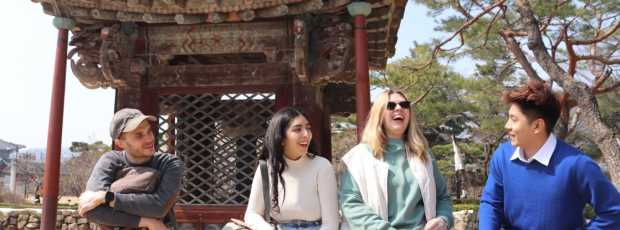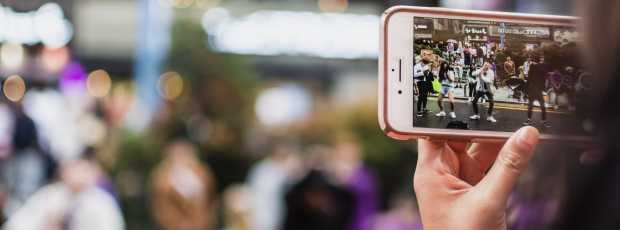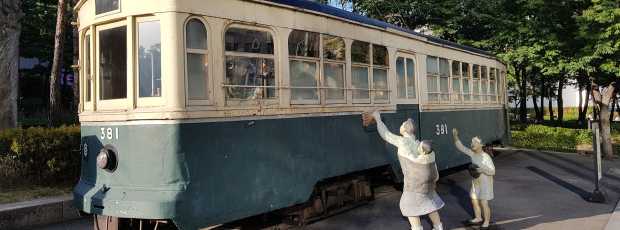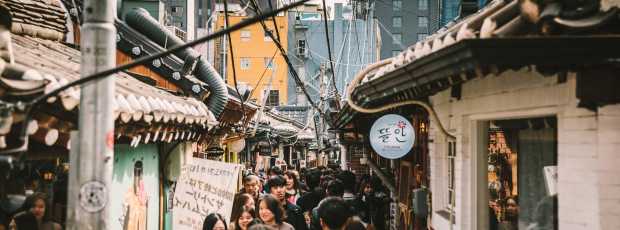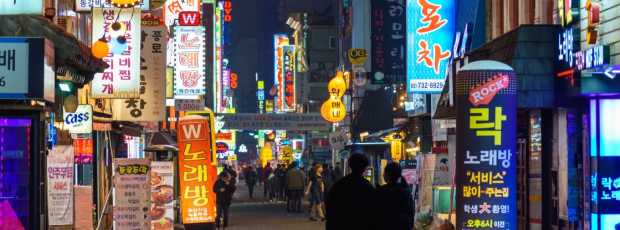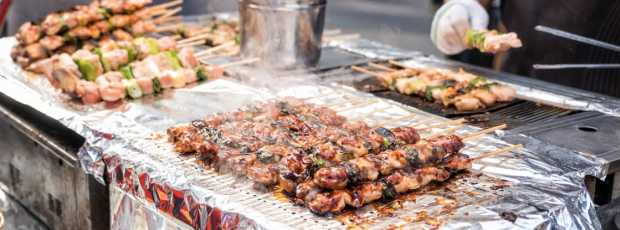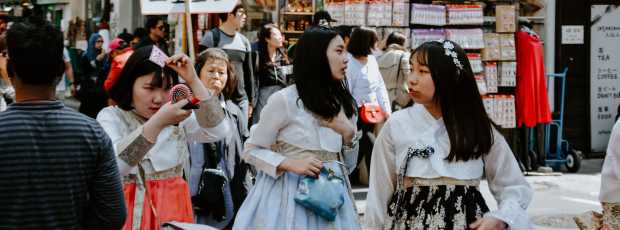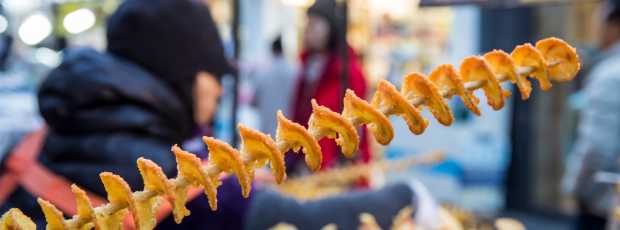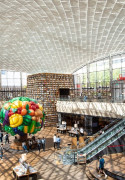What a wonderful first day in Seoul! Jeeson helped us with the ATM machine and purchasing T-cards before heading to the Palace and Secret Garden Tour. The street food and market walk afterwards was fun, interesting and delicious!Judith, Seoul, 2025
Table Of Contents
- Choosing Where to Stay in Seoul Changes Everything
- Which Seoul Neighborhoods Match Your Travel Style?
- How Do Seoul Neighborhoods Connect Across the City?
- Seochon: Seoul's West Village
- Buam-dong: Artist's Retreat in the Hills
- Eunpyeong Hanok Village: Traditional Meets Modern
- Ahyeon-dong: Working Seoul Authenticity
- Hongdae and Sinchon: University Energy
- Sillim-dong: Student Paradise
- Yeouido: Finance District Riverside
- Seoul Forest and Ttukseom: Urban Nature Hub
- Haebangchon: International Creative Hub
- Euljiro: Industrial Chic Nightlife
- Dongdaemun: Shopping and Late Night Fuel
- Mullae-dong: Industrial Arts District
- Where Should I Stay? Quick Decision Guide
- Sample Two-Night Base Strategies
- What Practical Tips Make Seoul Stays Smoother?
- Overrated or Misunderstood? Keep, Tweak, or Try This Instead
- Frequently Asked Questions
- Finding Your Perfect Seoul Neighborhood
I'm Alex Nam and I've been exploring Seoul neighborhoods for seven years now, long enough to watch whole districts transform from overlooked residential corners into creative hubs that locals brag about.
I host custom Seoul experiences with City Unscripted here, which means I've walked guests through Seochon's hanok lanes in morning fog, explained the PC bang culture in Sillim at midnight, and defended my favorite Ahyeon market stall against gentrification rumors at least a dozen times.

Aerial view of central Seoul with Han River dividing city
Choosing Where to Stay in Seoul Changes Everything
My relationship with this city started awkwardly. During my first extended stay in South Korea,
I picked a generic hotel near Myeongdong Shopping Street because the guidebook called it "central."
Three days in, I was spending two hours daily on the subway just reaching neighborhoods where Seoul's real character lived. The night I discovered Euljiro's retro bar alleys by accident,
I realized I'd been staying in the wrong Seoul entirely.
This sprawling city functions like several smaller cities stitched together by the Han River.
North of the water, you'll walk through palace gates and narrow hanok alleys where centuries-old traditional tea houses sit beside cute coffee shops run by third-generation owners.
South of the Han River, glass towers stretch upward while families cycle riverside paths that feel worlds away from the urban energy just blocks inland.
Your choice of where to stay in Seoul determines which version of this metropolis you experience. I've watched this play out countless times while guiding visitors.
One guest stayed in neon-soaked Hongdae for four nights and never saw a traditional building except in passing from taxi windows.
Another picked hanok-lined Seochon and missed the city's electric nightlife entirely. Both left convinced they'd seen the "real" Seoul, but they'd experienced two separate cities that barely overlapped.
The contrasts surprise first-time visitors most.
You can wake up in a traditional guesthouse with ondol floor heating, walk ten minutes to Seoul City Hall, then catch the subway to rooftop bars in Haebangchon with views of N Seoul Tower.
Your neighborhood base shapes every moment, from breakfast options to the sounds outside your window at 2 AM.
After seven years of testing Seoul districts personally and professionally, I've learned that distance matters less than daily rhythm.
The best neighborhoods in Seoul match your travel style rather than checking proximity boxes on a map.
This guide gives you my honest take on each area, including the ones guidebooks oversell and the corners they miss entirely.
Curious What You Won’t Find Online?
Discover the side of Seoul only locals talk about.
Which Seoul Neighborhoods Match Your Travel Style?

Collage of quick pick scenes
Before you pick a hotel, pick a rhythm. I match neighborhoods to how I want my days to feel, then let the subway handle the rest.
First-Time Visiting Seoul
Seochon: Hanok charm meets palace proximity. You're walking distance from Gyeongbokgung and staying in authentic traditional lanes. I always send first-timers here because it balances Korean culture with practical access.
Dongdaemun: Central location with serious shopping and 24-hour food options. The city's energy without the price tags of trendier districts. Perfect for exciting day trips in Seoul.
Food Lovers
Ahyeon-dong: Local market neighborhood where office workers grab lunch. Real Seoul eating without tourist markup. I've ordered the same kimchi jjigae at the same stall here for three years, and the auntie still charges me 7,000 won.
Sillim: Student area famous for fried chicken and late-night Korean BBQ. Where locals go for cheap eats that stretch your budget twice as far as the city center.
Nightlife Seekers
Hongdae: Student clubs, live music venues, and street performances until dawn. The classic choice for night owls, with direct access to Hongik University Station and the airport express.
Haebangchon: Rooftop bars with Namsan Park views and a more mature crowd than Hongdae's university scene. The craft beer selection here beats most trendy neighborhoods downtown.
Euljiro: Retro bars hidden in industrial alleys. Seoul's answer to Tokyo's Golden Gai, where photographers and artists gather after 9 PM.
Calmer Travelers
Buam-dong: Arty hillside cafés with mountain air. Perfect for slow mornings and creative exploration. The walk uphill from Line 3 takes fifteen minutes, but the city views make every step worthwhile.
Eunpyeong Hanok Village: Modern hanok stays with hiking trails outside your door. Less crowded than Bukchon Hanok Village but equally photogenic.
Seoul Forest area: Parks, riverside paths, and design-forward brunch spots. Urban nature at its best, with a deer park my nephew asks to visit every weekend.
Kids love the deer park while parents enjoy sophisticated café culture nearby.
Families
Yeouido: Cherry blossoms in spring, riverside cycling year-round, and family attractions like the floating island and Yeouido Hangang Park nearby. The spacious rooms in business hotels here give kids room to spread out.
Seoul Forest and Ttukseom: Kids love the deer park while parents enjoy sophisticated café culture nearby. The playgrounds scattered through this residential area stay busy until sunset.
Business Travelers
Yeouido: Finance district with luxury hotel options and direct airport connections. My consulting friends stay here because checkout-to-gate takes under an hour.
Budget Travelers
Dongdaemun: Night markets, cheap shopping, and budget hotel clusters. Street vendors serve meals for less than convenience store prices.
Sillim: Student neighborhood pricing with authentic nightlife and affordable private rooms. Many budget accommodations here offer private bathrooms, which surprised me the first time I booked.
If you’re torn, I recommend a quick “day rhythm” test: grab a Ddareungi public bike and ride 30 minutes along the river; if that feels like your Seoul, base near Yeouido or Seoul Forest. If you’d rather chase venues and basements, mark Hongdae and Euljiro for after dark.
Download KakaoMap and the Subway Korea app before you land; navigation is smoother than anything in English-only apps.
Imagine Having a Friend in Every City
Our locals share their city with you the way they live it: flexible, real, and unscripted.
See how it works
Seoul subway map graphic
How Do Seoul Neighborhoods Connect Across the City?
Seoul orients itself around the Han River, with history concentrated north and modern districts spreading south.
The subway system makes most areas accessible within 30 minutes, so your base becomes less about convenience and more about the daily vibe you want.
North of the Han River, you start with tradition in Seochon's hanok lanes, then climb toward Buam-dong's hillside cafés or explore Eunpyeong Hanok Village near Bukhansan mountains.
Local markets like Ahyeon show everyday Seoul life, while Dongdaemun buzzes with shopping and retro nightlife around Euljiro.
West side student hubs (Hongdae, Sinchon, and Sillim) keep the nights young with street food, clubs, and PC bangs.
Every student neighborhood offers its own character, though Sillim provides the most authentic local pricing.
South of the Han River, Yeouido's riverside parks and corporate towers mix with family-friendly green spaces around Seoul Forest and Ttukseom.
Hidden gems like creative zones such as Haebangchon's rooftop scene and Mullae's warehouse art spaces round out the city's personality.
Thanks to subway stations throughout central Seoul, you're never more than a T-Money card swipe away from a completely different experience.

Seochon alley with hanok and murals
Seochon: Seoul's West Village
When I want quiet mornings and palace walks before the crowds, I base myself in Seochon and let the hanok lanes set the pace.
Why Stay in This Historic Neighborhood?
This residential area west of Gyeongbokgung Palace feels like stepping into old Seoul without the commercial polish of more famous districts.
Walking these narrow streets lined with traditional Korean architecture, you discover the city's quieter creative side.
I first stayed in Seochon five years ago when a hanok guesthouse owner convinced me to book direct instead of using the hotel booking site.
She was right.
The neighborhood showed me a side of Korean culture I'd missed on previous trips focused on shopping centers and major attractions.
For a classic Seochon lunch, I still send friends to Tongin Market’s Dosirak Café. Buy the brass tokens, build your tray, eat outside if the weather’s good. Then walk the alleys toward Gyeongbokgung with a coffee in hand.
Who Should Choose Seochon?
History lovers who want authentic experiences, foodies seeking traditional tea houses, and travelers who prefer slow exploration over packed itineraries.
This works well if you're planning walking distance access to grand palaces without staying in obvious tourist zones.
What Makes Seochon Special?
Narrow hanok lanes wind between indie coffee shops, small art galleries, and century-old buildings. Morning light filters through traditional rooflines while locals in modern dress head to work through ancient pathways.
It's Seoul's creative bohemian heart, where you'll find more cute cafes than chain stores.
The neighborhood balance surprises most visitors. You're just a short walk from Gyeongbokgung Palace and the changing of the guard ceremony, but the surrounding streets feel residential rather than theme-park polished.
The Practical Side of Seochon
Tongin Market offers an authentic local experience through its famous "dosirak café" system. You buy brass tokens and build your own lunch tray from various vendors. Yes, it's become touristy, but the food stays good and the prices remain reasonable. I still grab lunch here when I'm showing visitors around.
Hotel options lean toward guesthouses and smaller properties rather than international chains.
If you need a boutique hotel with modern amenities, you'll find options, but don't expect Hilton-level facilities. The hanok guesthouses here offer traditional architecture with ondol floor heating, which takes adjustment if you're used to beds.
The neighborhood gets quite quiet after dinner. If nightlife matters, you'll need to hop on Line 3 and head elsewhere. But for morning people who want to photograph empty palace grounds at dawn, this location can't be beat.
Getting Around from Seochon
Gyeongbokgung Station on Line 3 puts you in the heart of things. Most local boutiques and galleries cluster within walking distance, and subway stations connect you easily to other Seoul districts.
The walk to Seoul City Hall takes about twenty minutes if you prefer surface streets to underground transfers.
Imagine Experiencing Seoul for Real
A local can show you the vibe, flavors, and hidden gems up close.

Buam-dong café terrace overlooking Seoul.
Buam-dong: Artist's Retreat in the Hills
If I need fresh air and clear views, I ride up to Buam-dong, sip a slow coffee, and watch the city soften below.
Why Choose This Hillside Neighborhood?
This quiet area north of Gyeongbokgung offers mountain air and creative energy without the crowds. It's Seoul's answer to an artist quarter, with galleries tucked into residential streets and panoramic cafés that make the uphill walk worthwhile.
I stumbled into Buam-dong by accident three years ago when following a gallery recommendation. The bus ride up felt like leaving the city entirely, but I was still only fifteen minutes from central Seoul.
Who Fits Buam-dong Best?
Artists and creatives, couples seeking romantic spots with city views, and casual hikers who want easy access to Inwangsan mountain trails. If you photograph for Instagram, the café terraces here provide Seoul Tower backdrops without paying observation deck prices.
The Buam-dong Experience
Calm and contemplative, with a noticeable mountain breeze even in summer. Boutique cafés serve excellent coffee while galleries showcase local artists.
The pace here slows down noticeably from the rush you'll feel around shopping street areas or subway stations during rush hour.
Do one slow coffee at Sanmotoonge for wide-angle city views, then wander down to the small galleries. Bring a sketchbook or just your notes app. The breeze up here resets your head after downtown.
What Works and What Doesn't
Peaceful atmosphere with stunning city views from elevated café terraces. You're close to excellent hiking trails on Inwangsan, and the creative café culture rivals anywhere in the city.
The residential area feels local rather than manufactured for tourists.
But accommodation options stay very limited, mostly guesthouses and small boutique hotels. This isn't a nightlife area, so evening entertainment requires heading to other neighborhoods via bus back to Line 3.
Sanmotoonge café has developed cult status for its panoramic Seoul views. I recommend arriving before 10 AM or after 3 PM to avoid the weekend crowds who come up specifically for photos.
Too Many Lists, Not Enough Clarity?
We make exploring simple by connecting you with someone who knows the city and helps you spend your time on what matters to you.
Eunpyeong Hanok Village with mountains
Eunpyeong Hanok Village: Traditional Meets Modern
On culture-heavy days, I sleep in Eunpyeong’s modern hanok, wake to mountains, then choose between tea rooms and trailheads.
Why Stay Near Bukhansan National Park?
This newer hanok development offers traditional Korean architecture with modern amenities, backed by the green slopes of Bukhansan National Park. It's traditional stay experience without the tourist crowds of Bukchon Hanok Village in central Seoul.
A photographer friend stayed here last spring and sent me photos that looked too good to be real.
The traditional wooden buildings with mountain ridges behind them create compositions you won't find elsewhere in Seoul districts.
Who Should Book Eunpyeong?
Families wanting cultural immersion, couples seeking unique accommodations, and anyone who appreciates traditional Korean architecture but wants private bathrooms and wifi.
The hiking access makes this perfect for active travelers who want nature and culture in one location.
My suggestion: book a night in a modern hanok, wake early, then hop to nearby Bukhansan trailheads. If you’re not staying overnight, come for tea and a photo stroll before the buses get busy.
Living in Modern Hanok
Serene and traditional, but with the comfort of contemporary construction. These hanok buildings maintain classical aesthetics while offering modern conveniences. The mountain backdrop adds natural tranquility you won't find in other Seoul neighborhoods.
You can stay in beautifully maintained hanok buildings without fighting crowds. The area provides easy access to Bukhansan hiking trails, and the traditional tea houses here feel genuinely peaceful rather than performance spaces for tour groups.
The development is still growing, which means fewer restaurants and shops compared to established neighborhoods. Evening entertainment options remain limited, though the sunset views from rooftop terraces compensate somewhat.
Getting to Eunpyeong Hanok Village
Take Line 3 to Gupabal Station, then a short bus ride brings you to the village. The area works best for travelers comfortable with slightly more remote locations. Budget an extra twenty minutes when planning trips to central Seoul compared to staying downtown.
This makes an excellent base for serious hiking in Bukhansan National Park.
Multiple trail access points sit just minutes away, and returning to a hanok stay after a mountain day feels more authentic than collapsing in a generic hotel.
See Seoul Beyond the Checklist
Discover the city guidebooks don’t cover with a local by your side.

Street food stall in Ahyeon Market
Ahyeon-dong: Working Seoul Authenticity
When my appetite leads, I cut across to Ahyeon for market lunches and no-frills spots that feed office workers, not tour buses.
Why Stay in This Underrated Neighborhood?
This area between Mapo and downtown showcases working-class Seoul with exceptional local food and furniture markets. You'll experience the city as residents do, without any tourist polish getting in the way.
I discovered Ahyeon-dong when a Korean colleague invited me to lunch near her office.
The stew we ate cost less than a Starbucks latte, and I've been recommending this neighborhood for authentic meals ever since.
Who Belongs in Ahyeon-dong?
Food lovers wanting authentic Korean cuisine, budget travelers seeking value, and cultural explorers interested in residential Seoul life. If you want to eat where office workers eat, this delivers.
Come hungry for a market-style lunch around Ahyeon Market, then walk Ahyeon Furniture Street to peek into workshops. You'll see everyday Seoul, not a stage set. Expect fewer English menus and better prices.
The Real Seoul Vibe
Working-class Seoul with genuine warmth and grit. Furniture Street vendors work alongside tiny restaurants serving office workers. It's unpolished Seoul without any attempt to cater to foreign tourists.
Furniture Street offers unique shopping experiences you won't find in shopping centers.
The authentic eateries serve incredible food at local prices rather than the foreign cuisine chains found in tourist areas. Line 2 access connects you easily to both Hongdae and attractions throughout central Seoul.
But English menus are rare, and the decidedly local atmosphere might challenge some international travelers. You won't find luxury hotel options here either.
Transportation from Ahyeon-dong
Ahyeon Station on Line 2 provides excellent connectivity throughout the city. You're well-positioned for exploring both traditional and modern Seoul neighborhoods. The location serves as a practical mid-point base between Hongdae's energy and Gyeongbokgung's history.
This neighborhood taught me that Seoul's best food exists far from shopping street tourist zones.
The market aunties here don't speak English, but they understand hungry, and the prices reflect what locals actually pay.

Street performers in Hongdae
Hongdae and Sinchon: University Energy
For a late start and a later finish, I drift through Hongdae and Sinchon, chasing live music and cheap bites until the streets thin.
Why Base Yourself in Student Central?
The epicenter of Seoul's youth culture, where Hongik University students fuel an incredible live music and club scene.
This is Seoul at its most energetic and creative, powered by cheap eats and cheaper beer.
My first night in Hongdae, I followed street music until 3 AM and discovered five different live venues, none of which appeared in guidebooks. That remains my favorite introduction to any city.
Who Thrives in Hongdae?
Students and young travelers, nightlife seekers, budget-conscious visitors, and anyone who thrives on creative energy. This place gives you a proper taste of Seoul at night and all its excitement.
The Hongdae Atmosphere
Indie music venues, street art, and buzzing late-night energy. The area pulses with student life, from afternoon café culture to 4 AM club scenes. Creative and slightly chaotic, but that's the appeal.
You'll find incredible cheap eats everywhere, live music performances most nights, and budget accommodations throughout the area.
Hongik University Station connects directly to Incheon Airport via AREX, which helps when you're catching early flights. Street vendors and night markets keep the streets lively well past midnight.
But it gets very noisy, especially on weekends when the party crowd peaks. The area can feel overwhelming if you prefer quieter travel experiences.
During peak hours, the pedestrian density rivals Tokyo's Shibuya.
Pre-game with a gallery browse at KT&G Sangsangmadang, then follow the music. Buskers around the playground, live rooms after 10 PM. If your flight’s next morning, AREX from Hongik Univ. Station makes this base painless.
Hongdae Shopping Street Reality Check
The main Hongdae Shopping Street has become more commercialized than locals prefer. For authentic energy, stick to the side streets and live venues rather than the main drag.
The real Hongdae happens in basement clubs and rooftop bars, not the chain stores lining the tourist route.
Free street busker performances happen every weekend in Hongdae playground.
The musicians range from terrible to incredible, but watching the crowd interact beats any paid show. The area stays active later than most other Seoul neighborhoods, with some venues not even opening until midnight.

Neon sign alley in Sillim at night
Sillim-dong: Student Paradise
If I am counting won and chasing local nights, Sillim keeps me fed, entertained, and up later than I planned.
Why Choose Seoul's Budget Gaming Hub?
This student-heavy district offers authentic Korean nightlife culture with incredible value.
It's where locals go for serious fried chicken and late-night gaming sessions at PC bangs that serve surprisingly good comfort food.
I'd heard about Sillim's reputation but didn't visit until a gamer friend insisted. The neighborhood's energy surprised me. Less polished than Hongdae but more genuinely local.
Who Fits Sillim Best?
Budget travelers, gaming enthusiasts, fried chicken fans, and anyone wanting to experience authentic Korean student culture. If you want your money to go twice as far, this delivers.
The Sillim Experience
Neon signs advertising karaoke rooms (noraebang), PC gaming cafés, and casual Korean BBQ joints. The energy builds as the sun sets and students finish classes. It's youth culture without the international tourist overlay you'll find in Hongdae.
Sillim's Practical Advantages
Genuinely affordable accommodations and meals, an authentic student nightlife experience, and direct Line 2 access to central Seoul.
Many restaurants stay open very late, and the gaming culture here is legendary. Most budget accommodations offer private bathrooms despite the low prices, which elevates the experience beyond typical hostel stays.
But upscale hotel options don't exist here, and nights get quite loud when the student party scene peaks. The area caters primarily to local tastes, which means fewer concessions to international preferences.
Sillim Station on Line 2 provides direct access to most major destinations without transfers. You're looking at 25-30 minutes to reach Dongdaemun or Gangnam areas.
The PC Bang Reality
Some PC bangs operate 24 hours and serve surprisingly good comfort food.
I've watched Korean students spend entire nights here gaming, ordering ramyeon and chicken between matches. The culture around these spaces is uniquely Korean and worth experiencing even if you're not a serious gamer.
Want to Experience Seoul's Family Fun Firsthand?
Step into the neighborhood, scene, or story with someone who knows it inside out.

Yeouido cherry blossoms in spring
Yeouido: Finance District Riverside
When I want space to think and room to run, I stay by the river in Yeouido, jog at sunrise, and plan the day over a long coffee.
Why Stay in Seoul's Business Center?
Seoul's finance center transforms into a peaceful riverside retreat after business hours.
Corporate towers give way to cherry blossom parks and cycling paths along the Han River, creating unexpected contrasts throughout the day.
I first stayed in Yeouido for a business trip and expected sterile corporate accommodation.
Instead, I discovered riverside parks perfect for morning runs and luxury hotel rooms with actual space to work.
Who Should Book Yeouido?
Business travelers, runners and cycling enthusiasts, cherry blossom seekers, and visitors wanting spacious rooms with natural spaces nearby. The Olympic Park access and peaceful atmosphere work well for families too.
The Yeouido Vibe
Glass towers and suited professionals by day, then riverside calm and family picnics by evening. It's Seoul's attempt at balancing urban development with green space, and it works better than you'd expect.
What Works in Yeouido
Riverside parks are perfect for morning runs or evening walks. The spectacular cherry blossoms in spring draw crowds, but the festival atmosphere adds energy rather than ruining the experience.
Several luxury hotel options offer spacious rooms, which matters when you're staying longer than a weekend.
Dining options can be expensive and business-focused, which means you're paying premium prices for lunch near the office towers.
The area becomes quite quiet after standard work hours when office workers head home.
Yeouido Station provides excellent subway connections, and the riverside cycling paths extend for miles in both directions.
You can rent bikes and ride all the way to Seoul Forest if you're ambitious.
Local Yeouido Culture
Locals often picnic here with delivery fried chicken and beer. It's a surprisingly laid-back tradition that contrasts with the corporate atmosphere during business hours.
The best spots fill up fast on spring weekends, so arrive early if you're visiting during cherry blossom season.

Riverside park near Seoul Forest
Seoul Forest and Ttukseom: Urban Nature Hub
For green paths and easy resets, I start in Seoul Forest, ride the riverside, then slip into Seongsu cafés when the sun gets high.
Why Base Near Seoul's Green Escape?
This riverside neighborhood balances green space with sophisticated urban amenities. Seoul Forest provides genuine nature experiences while the surrounding area offers design-forward café culture that rivals any trendy neighborhood.
My nephew asks to visit Seoul Forest every time we see each other. The deer park became his favorite Seoul attraction, which surprised me until I watched him spend an hour just observing them.
Who Should Stay Near Seoul Forest?
Families with children, morning joggers, couples wanting romantic settings, and travelers who appreciate both nature and modern Seoul life. The mix of outdoor space and cute coffee shops creates flexibility for different moods.
The Seoul Forest Experience
Green escape meets modern brunch culture. Tree-lined paths lead to contemporary cafés with floor to ceiling windows and natural light.
It's Seoul's most successful integration of park life with urban sophistication.
Seoul Forest offers deer encounters and butterfly gardens that kids love.
Riverside cycling paths extend for miles, and the café scene rivals any Seoul neighborhoods known for coffee culture. Public art installations throughout the park provide interesting moments without the crowds you'd find at commercial destinations like Coex Mall or Starfield Coex Mall.
But nightlife options stay limited compared to student neighborhood areas, and accommodation leans toward serviced apartments rather than traditional hotels.
I recommend you start at Seoul Forest’s Deer Corral (kids love it even with the fence), coffee at Café Onion Seongsu, then a riverside loop from Ttukseom. Early mornings here feel like a different city.
Getting Around Seoul Forest
Seoul Forest Station on the Bundang Line or Ttukseom Station on Line 2 both provide easy access. The area works well for exploring both traditional and modern attractions across the city.
The deer park inside Seoul Forest has become incredibly popular with families. Children can observe and sometimes feed the gentle deer in a controlled environment.
Weekend mornings bring crowds, so visit before 10 AM or after 3 PM for better experiences.
Want to Experience Seoul's Markets and Unique Culture?
Explore everything the city has to offer with a local who knows where to go.

Rooftop view from Haebangchon towards Namsan Tower
Haebangchon: International Creative Hub
On social nights, I climb to HBC, trade rooftops for conversation, and watch the tower glow while the city hums below.
Why Stay in This Hillside Neighborhood?
This area near Itaewon blends Korean residential culture with international creativity. Expat communities and local artists have created something uniquely Seoul here, different from both traditional neighborhoods and corporate zones.
A friend moved to Haebangchon two years ago and insists the rooftop bar views beat any paid observation deck. After visiting his place, I had to agree. The Seoul Tower perspectives from neighborhood rooftops provide better atmosphere than tourist spots.
Who Fits Haebangchon?
International travelers, creatives and artists, anyone seeking expat community connections, and nightlife seekers wanting something different from typical tourist spots. The indie scene here attracts people who prefer craft beer to club music.
The HBC Vibe
Quirky hillside streets mix craft beer bars with traditional Korean homes. International restaurants and foreign cuisine options sit next to local family businesses, though the Korean spots often provide more memorable experiences.
Strong indie and expat community creates unique cultural mixing. It's quieter than Itaewon proper but still lively, with a rooftop bar scene that offers incredible Seoul Tower views.
You're within walking distance to major attractions and cultural sites like Leeum Museum when you need indoor art between rooftop adventures.
For views without the crowds, I like The Royal Food & Drink near the ridge. Daytime brunch, golden-hour skyline, then slide into a low-key pint at Phillies Pub when there’s live music on festival weekends.
Haebangchon Challenges
Steep hills make walking challenging for some visitors. I'm reasonably fit and still arrive at rooftop venues breathing hard.
The area maintains a more rough-around-the-edges feel than polished tourist districts, which some travelers find charming and others find off-putting.
Noksapyeong Station on Line 6 puts you within walking distance, though the hillside location requires uphill effort regardless of which direction you approach from.
Several rooftop bars here offer underrated views of N Seoul Tower and Namsan Park, often with better prices and smaller crowds than famous observation decks.
The sunset timing works perfectly for drinks before dinner.

Retro alley grill restaurant in Euljiro
Euljiro: Industrial Chic Nightlife
When I want grit with character, I weave through Euljiro’s alleys, find a tiny bar, and let the neon guide the evening.
Why Choose This Retro Bar District?
Former industrial district where old printing workshops now house retro bars and underground music venues.
This is Seoul's grittiest creative transformation, where neon signs and metal workshops create photogenic contrasts.
I discovered Euljiro through a photographer who insisted I needed to see it. Walking these alleys at night feels like stepping into Blade Runner, but with better music and cheaper drinks.
Who Belongs in Euljiro?
Artists and photographers, offbeat explorers, serious bar hoppers, and travelers seeking authentic underground culture. If you prioritize unique atmosphere over comfort, Euljiro delivers.
The Euljiro Scene
Industrial alleys filled with neon signs and hidden bars. Street art covers old factory walls while new venues occupy converted workshops.
Locals call it "Hipjiro" for good reason, though the industrial heritage remains visible.
Unique retro bar scene unlike anywhere else in Seoul districts.
Incredible street art and art installations transform what could be gritty into photogenic.
Drinks stay affordable in atmospheric settings that feel discovered rather than designed.
Euljiro's Limitations
Very few hotel options exist here. Most visitors stay in nearby neighborhoods and come to Euljiro specifically for nightlife. The industrial aesthetic isn't for everyone, and some alleys can feel unsafe to visitors unfamiliar with Seoul's generally low crime rates.
Euljiro-3-ga Station provides central access, and most bars cluster within walking distance.
The neighborhood really comes alive after 9 PM when office workers finish their day and creative types start their evening.
Many venues here are tiny and fill up quickly on weekends.
Experiences Created by Locals, Just for You
See the city through the eyes of the people who call it home.

Dongdaemun Design Plaza at night
Dongdaemun: Shopping and Late Night Fuel
If my clock goes offbeat, I land in Dongdaemun, shop after midnight, then eat my way along the stalls until I am ready to sleep.
Why Base in Seoul's 24-Hour District?
Seoul's traditional garment district has evolved into a 24-hour shopping and eating destination. Night markets and fashion wholesale create constant activity that never quite stops.
My most memorable Dongdaemun experience involved following street food vendors from stall to stall at 2 AM, eating my way through a night when jetlag kept me awake.
The neighborhood accommodates any schedule.
Who Should Stay in Dongdaemun?
Bargain hunters, late-night eaters, budget travelers, and shopping enthusiasts who want authentic Korean fashion rather than luxury brands. If your ideal vacation involves retail therapy followed by street food, this works.

Dongdaemun Design Plaza LED rose garden illuminated at night
The Dongdaemun Experience
Neon-lit shopping streets and 24-hour food stalls create constant buzzing energy. It's commercial Seoul with real local flavor rather than tourist polish. The wholesale markets open when most neighborhoods close.
Budget hotel clusters make accommodation affordable. Incredible shopping options range from wholesale to retail, and street vendors operate around the clock. Unlike the predictable retail experience of Coex Mall or Starfield Coex Mall, Dongdaemun's markets offer genuine discovery and bargaining culture.
The area gets very crowded during peak shopping hours, especially weekends when tour buses arrive. It maintains a somewhat gritty commercial feel that might not suit travelers seeking polished experiences.
Transportation and Access
Dongdaemun Station and multiple nearby subway stations provide excellent connectivity to all Seoul neighborhoods and major attractions. This centrally located base makes day trips from Seoul simple.
The Dongdaemun Design Plaza's LED rose garden creates spectacular nighttime displays. It's one of Seoul's most photogenic spots after dark, and you can visit for free. While the area offers plenty of retail therapy opportunities, the real magic happens in late-night food stalls where locals gather after shopping.

Street art on old factory wall in Mullae
Mullae-dong: Industrial Arts District
For creative sparks, I head to Mullae, where welders and painters share streets and every corner begs for one more photo.
Why Stay Near Seoul's Creative Workshops?
Old steel workshop district transformed into Seoul's most authentic arts community.
Warehouses now house artist studios, unique cafés, and experimental music venues, all while metalworking shops continue operating.
A sculptor friend works in Mullae-dong and invited me to her studio opening. Watching artists and welders share the same streets showed me a side of Seoul I'd never expected.
Who Fits Mullae-dong?
Creatives and artists, photographers seeking unique backdrops, and offbeat explorers who appreciate industrial aesthetic mixed with artistic innovation.
If you want to understand Seoul's creative underground, start here.
The Mullae-dong Atmosphere
Industrial grit meets creative transformation. Original factory buildings house contemporary art spaces while metalworking shops operate alongside boutique café culture.
It's Seoul's most successful industrial district revival, preserving working history while adding new layers.
Warehouse cafés offer atmospheric experiences you won't find in conventional Seoul neighborhoods.
Art galleries and studios provide authentic creative community access rather than commercial gallery tourism.
The photography opportunities are endless, from street art to working factories to converted performance spaces.
But accommodation options stay very limited.
The area becomes quite quiet in evenings after art spaces close, which seems counterintuitive for an arts district but reflects the working schedule of the studios.
Sip something strong at a warehouse café (try Pont Café), wander Mullae Artist Village, and check if Mullae Metal City events are on. This neighborhood flips from clang to culture by evening.
Getting to Mullae-dong
Mullae Station on Line 2 provides easy access, though the district requires walking to explore properly. The industrial landscape isn't compact like a shopping street.
Several cafés here double as live music venues, hosting intimate concerts and art events you won't find in more commercial districts.
The shows I've attended here felt like insider secrets rather than ticketed performances.
These are Not Just Places on a List
Experience it all through hidden corners and stories most visitors miss.

Traditional Korean palace gate with modern Seoul skyline in background
Where Should I Stay? Quick Decision Guide
If you know how you travel, the answer is simple. Match your mood to a base, then save your energy for the good stuff.
For Neon Lovers
Stay in Sillim or Euljiro, where late-night neon creates Seoul's most atmospheric nighttime wandering. Both neighborhoods embrace artificial light as aesthetic rather than utility.
For History Seekers
Stay in Seochon for authentic hanok experiences or Eunpyeong for traditional architecture without tourist crowds. Both provide Korean culture immersion while maintaining residential authenticity.
For Families with Kids
Stay in Seoul Forest for deer encounters and playground access, or Yeouido for riverside cycling and family attractions. Both areas balance kid-friendly activities with sophisticated parent amenities.
For Serious Foodies
Stay in Ahyeon-dong for authentic local markets or Sillim for legendary student-priced Korean BBQ and fried chicken. If you want to know what to eat in Seoul, these neighborhoods teach you.

Korean BBQ restaurant in Sillim with students grilling meat
For Budget-Conscious Travelers
Stay in Dongdaemun for cheaper accommodation and 24-hour food options, or Sillim for student pricing on everything from meals to private rooms with private bathrooms.
For Luxury Seekers
Stay in Yeouido for riverside luxury hotel options with spacious rooms and business amenities. The corporate focus means higher service standards than most Seoul districts.
For Creative Types
Stay in Mullae-dong for warehouse art spaces or Buam-dong for hillside gallery culture. Both neighborhoods attract artists and provide creative inspiration through their physical environments.
For Nightlife Enthusiasts
Stay in Hongdae for student club energy or Haebangchon for sophisticated rooftop bar scenes. Both deliver after-dark excitement but for different age groups and styles.
For Nature Lovers
Stay in Seoul Forest for urban parks or Eunpyeong for mountain access and hiking trails. Both balance natural spaces with city convenience.
For First Time Visitors
Stay in Seochon for cultural immersion or Dongdaemun for central location and budget-friendly exploring. Both provide authentic Seoul experiences from different perspectives.
Two fast filters I use with guests:
- If you want nature within five minutes, pick Seoul Forest or Yeouido and rent Ddareungi bikes.
- If your nights run late, base in Hongdae (AREX access) and plan one Euljiro crawl. Apps you’ll actually use: KakaoMap + Subway Korea.

PC bang gaming cafe with neon lights and students playing
Sample Two-Night Base Strategies
If you know how you travel, the answer is simple. Match your mood to a base, then save your energy for the good stuff.
Maximum Seoul Energy
Night 1: Hongdae for university nightlife and street performances. Experience Seoul's youthful creative energy firsthand, staying out late to catch the real club scene that starts after midnight.
Night 2: Sillim for authentic student food culture and PC bang gaming experiences. See how locals spend their evenings beyond the tourist-facing entertainment zones.
This strategy immerses you in Seoul's electric youth culture while providing genuine Korean social experiences that don't appear in guidebooks.

Traditional Korean market vendor preparing fresh kimchi
Food-First Seoul
Night 1: Ahyeon-dong for authentic market meals and Furniture Street browsing. Eat where office workers go for lunch, experiencing real Korean home cooking at local prices.
Night 2: Seoul Forest area for sophisticated café culture and international dining options mixed with Korean fusion. Balance traditional flavors with modern Seoul innovation.
This approach focuses on authentic eating experiences ranging from traditional markets to contemporary Seoul food culture that pushes Korean cuisine forward.
Hungry to Try Seoul's Food Yourself?
Taste and explore the flavors locals actually love.

Children feeding deer at Seoul Forest
Family Seoul Discovery
Night 1: Seoul Forest for deer park adventures and family-friendly green spaces. Kids love the interactive nature experiences and playgrounds scattered throughout.
Night 2: Yeouido for riverside cycling and cherry blossom viewing (seasonal). Enjoy family picnics, cultural sites, and safe evening walking along well-lit paths.
Both areas provide safe, engaging experiences for children while offering sophisticated amenities for parents. The residential area atmosphere helps kids see how Seoul families live.
Culture and History Shuttle
Night 1: Seochon for hanok guesthouses and traditional palace proximity. Sleep in traditional Korean architecture while maintaining modern convenience and private bathrooms.
Night 2: Eunpyeong for mountain hanok experiences and hiking culture. Extend traditional immersion with natural settings and access to Bukhansan trails.
This approach maximizes traditional Korean cultural experiences while providing varied settings and daily rhythms across two different neighborhood characters.
Want to Experience Seoul's Nature Firsthand?
Step into Seoul neighborhood, scene, or story with someone who knows it inside out.
What Practical Tips Make Seoul Stays Smoother?
A few smart choices change everything. Think floors for quiet, trains for timing, and light bags for easy days.
Managing Noise in Busy Districts
Book higher floors in areas like Hongdae, Sillim, and Dongdaemun. Seoul's street life continues late, especially on weekends, so elevation helps with sleep quality. When I stayed on the second floor in Hongdae, I learned this lesson the hard way at 3 AM.
Request rooms facing away from main streets if ground-level accommodation is your only option. The noise difference between street-side and interior rooms can mean three hours of extra sleep.

Seoul subway station platform late at night
Understanding Subway Timing
Seoul's subway system stops running around 12:30 AM, with last trains varying by line.
Check your specific route's schedule before assuming you can subway home from late-night activities.
Night buses operate after subway hours, but service becomes less frequent and routes change.
The first trains typically start around 5:30 AM, which helps if you're catching early flights or want to photograph major attractions before crowds arrive.
Airport Access
AREX (Airport Railroad Express) provides the fastest connections to central Seoul, while airport buses offer cheaper alternatives with multiple stop options throughout the city.
Cherry Blossom Rush
Spring accommodation books up months in advance, particularly in Yeouido and areas near Namsan Park. Plan cherry blossom visits well ahead of your travel dates.

T-Money card machine
Hotel vs. Guesthouse Culture
Luxury hotel options cluster in business districts like Yeouido, while traditional hanok guesthouses operate in historic neighborhoods. Many boutique hotel properties offer middle-ground solutions with private bathrooms and modern amenities in traditional settings.
Walking Distance Reality
Seoul's compact design means most attractions stay within just a short walk of subway stations, even in residential neighborhoods.
Overrated or Misunderstood? Keep, Tweak, or Try This Instead
Seoul has its tourist traps like any major city, but some famous spots just need better timing or realistic expectations rather than complete avoidance.
After seven years of fielding the same questions from visitors, I've learned which Seoul neighborhoods and attractions get unfairly hyped and which ones work if you approach them differently.
Bukchon Hanok Village
The Reality: This Instagram-famous hanok district suffers from its own success. The narrow lanes get packed with tour groups by 10 AM, and residents have posted signs asking tourists to keep quiet because, you know, people live here.
Tweak It: Visit before 8 AM or after 5 PM when the tour buses leave.
Skip the main photo-op alleys entirely and wander the residential streets where locals hang laundry and grandmothers sweep doorsteps. The experience improves dramatically when you're not shoulder-to-shoulder with selfie sticks.
Better Alternative: Seochon offers lived-in hanok streets with a fraction of Bukchon's crowds.
The traditional Korean architecture feels more authentic because it's still functioning as a residential neighborhood rather than an open-air museum.
You'll find cute cafes and local boutiques instead of souvenir shops, and nobody glares at you for existing in their neighborhood.

Quiet Seochon hanok alley in early morning with resident sweeping doorstep and traditional wooden gate
See This Lovely Village For Yourself
A local can take you to the best spots in the area, giving you an immersive and personal experience.
Myeongdong Shopping Street
The Reality: This shopping district once served as Seoul's retail heart, but it's evolved into a tourist corridor with aggressive skincare sales tactics and prices marked up for foreign visitors.
I watched Myeongdong Shopping Street transform over the past decade from local shopping destination to something that feels more like an outdoor duty-free zone.
Tweak It: Use Myeongdong as a quick street food stop early in the morning before tour buses arrive.
The breakfast vendors serve decent hotteok and egg bread, and you can grab what you need and leave before the crowds make navigation frustrating.
Think of it as a 20-minute snack run, not a destination.
Better Alternative: Dongdaemun night markets deliver more local energy and better value.
The wholesale fashion district operates on Korean shopping rhythms rather than tourist schedules, and the street vendors here price for locals who know the going rates.
You'll find more authentic Seoul shopping culture and save money in the process.
Coex and Starfield Coex Mall
The Reality: These massive underground shopping centers offer air conditioning and entertainment but feel disconnected from Seoul's actual character. I've sent exactly zero friends here unless weather forced indoor plans.
Keep It For: Rainy days with kids who need to burn energy.
The Starfield Library makes decent photos, and the aquarium works when outdoor options fail. It's generic mall experience, but sometimes that's what a family trip needs.
Better Alternative: Seoul Forest and Ttukseom provide outdoor play, modern cafés, and riverside rides that show you actual Seoul neighborhoods rather than international retail chains.
Kids enjoy the deer park more than shopping centers, and parents get better coffee at design-forward cafés overlooking the Han River.
Even on partially cloudy days, this choice beats fluorescent-lit mall wandering.
Why This Matters for Your Seoul Stay
Tourist traps exist because they offer convenience and recognizable experiences.
But choosing Seoul neighborhoods and attractions that protect your time, budget, and atmosphere means you'll leave with stories about Korea rather than stories that could have happened anywhere.
I've guided visitors who insisted on hitting every famous spot, and I've guided others who trusted local alternatives. The second group always reports better trips.
They spent less money, fought fewer crowds, and experienced more moments that felt distinctively Seoul.
Before You Go, Talk to Someone Who Knows
A local video call helps you plan the trip that’s right for you.
Frequently Asked Questions
1) Where Should I Stay in Seoul for the First Time?
Seochon offers the best balance of cultural immersion and accessibility for first-time visitors. You'll experience traditional Korean architecture while staying walking distance from major attractions like grand palaces. The neighborhood provides authentic Seoul flavor without overwhelming new visitors.
Dongdaemun works as an alternative if budget matters more than traditional atmosphere. The central location makes navigation simple, and the 24-hour food options help with jetlag.
2) What's the Best Seoul Neighborhood for Food Lovers?
Ahyeon-dong delivers the most authentic local eating experience, with market vendors and family restaurants serving office workers daily. The food reflects what Seoul residents eat rather than tourist-adapted versions.
For variety and volume, Sillim provides incredible student-priced Korean BBQ and late-night fried chicken culture that locals enjoy. The pricing lets you try more dishes without breaking your budget.
3) Which Areas Feel Safest for Solo Travelers at Night?
All Seoul neighborhoods maintain excellent safety standards compared to most major cities. Seoul Forest and Yeouido offer particularly well-lit, family-friendly environments perfect for solo exploration after dark.

Tranquil Seoul Forest path
Both areas provide excellent evening walking opportunities with good lighting and regular foot traffic. I regularly walk alone at night in Seoul and feel safer than in most Western cities.
4) Where Should I Base for Easy Day Trips to DMZ or Suwon?
Central Seoul locations like Dongdaemun provide the best access to express buses and tour departure points for DMZ visits. Most tours pick up from multiple centrally located hotels or meet at City Hall.
The central location also offers multiple transportation options for Suwon day trips via subway or bus. Visiting Seoul's neighboring attractions becomes simpler when you're already positioned near major transit hubs.

DMZ viewpoint of the border between North and South Korea
5) Is Myeongdong Too Touristy to Stay In?
Myeongdong Shopping Street offers convenience and international brands, but areas like Seochon or Ahyeon-dong provide more authentic Korean culture experiences. The tourist crowds and markup pricing typical of heavily visited areas can be avoided by staying elsewhere.
Use Myeongdong for quick street food runs if you're in the area, but don't base your entire stay there. The neighborhood serves a purpose but doesn't represent authentic Seoul life.
6) Where Can I Stay for Palace Views?
Seochon offers the closest proximity to Gyeongbokgung Palace, with some hanok guesthouses and boutique hotel properties providing traditional architecture views. You can't see into the palace grounds from accommodation, but the neighborhood's traditional rooflines create similar aesthetic atmosphere.
Haebangchon's rooftop terrace venues offer distant palace views mixed with Seoul Tower perspectives. These elevated positions provide panoramic city views that include multiple landmarks.
7) What's the Most Convenient Base for Lotte World?
Seoul Forest area provides easy access to the theme park while offering family-friendly accommodations and amenities. The Bundang Line connects efficiently to Jamsil, where Lotte World operates.
This positioning lets you visit the theme park without staying in the touristy Jamsil area itself. You get better neighborhood character while maintaining convenient access to family attractions.

A view of Magic Island at Lotte World
8) Where Should I Stay on a Tight Budget?
Sillim offers the best combination of cheaper accommodation and authentic local food pricing. The student neighbouhood provides genuine Korean cultural experiences without tourist markup, plus excellent subway connections throughout the city.
Many accommodations here include private bathrooms despite low prices, which surprised me compared to hostel-style budget stays. The private rooms maintain privacy while keeping costs down.
9) What's the Quietest Area with Good Transport Links?
Buam-dong provides mountain-air tranquility with bus connections to central Seoul subway stations. The hillside location removes you from street-level noise while keeping you within 25 minutes of downtown.
For quieter options with direct subway access, Seoul Forest area balances peaceful park proximity with urban convenience. The residential area stays calmer than student neighborhood zones while offering similar transit connectivity.
10) What Are the Best Nightlife Neighborhoods Beyond Tourist Areas?
Euljiro offers the most authentic Korean nightlife culture in converted industrial spaces. The retro bars and underground music venues attract locals and creative types rather than international tourists.
Haebangchon provides sophisticated rooftop lounge experiences with local and expat mixing. The craft beer scene here developed organically rather than being designed for tourists.
11) Should I Stay North or South of the Han River?
North of the Han River offers traditional culture, royal palaces, and historic neighborhoods like Bukchon Hanok Village. South provides modern amenities, business districts, and family attractions around parks.
Your choice depends on whether you prioritize Korean culture immersion or contemporary Seoul experiences. The subway makes both accessible regardless of where you base, so pick based on daily vibe preference.
12) Which Seoul Areas Are Best During Cherry Blossom Season?
Yeouido becomes Seoul's cherry blossom headquarters in spring, with festival atmosphere and riverside picnicking. The concentration of trees along the river creates tunnel effects that photograph beautifully.
Namsan Park areas also provide beautiful blooms with Seoul Tower backdrop views. The hillside locations offer elevated perspectives of cherry blossoms against urban landscapes.
13) What's the Easiest Neighborhood for Airport Access?
Hongdae offers direct AREX connections to Incheon Airport via Hongik University Station. The express train reaches the airport in about 45 minutes, making early morning flights manageable.
Central Seoul neighborhoods like Myeongdong and City Hall area provide multiple airport bus options. Consider travel time versus neighborhood character when making airport access decisions.
14) Where Can I Stay Close to Both History and Nightlife?
Seochon provides the balance, traditional hanok culture and palace access during the day, with easy subway access to Hongdae or Euljiro nightlife scenes in the evening. Line 3 connects you quickly to other districts.
This positioning lets you explore Korean culture by day without sacrificing nighttime entertainment options. The quiet Seochon evenings mean better sleep between adventures.
15) Which Seoul Neighborhoods Have the Best Café Culture?
Buam-dong offers the most sophisticated hillside café experiences with city views. The artistic community here takes coffee seriously, and the elevated terraces provide Seoul Tower backdrops.
Seoul Forest area provides contemporary design-forward coffee shops with floor to ceiling windows and natural light. Both areas attract serious coffee enthusiasts and provide unique atmospheric settings beyond generic cute cafes.

Panoramic view of Seoul skyline at night from Namsan Tower
Finding Your Perfect Seoul Neighborhood
Seoul neighborhoods function like choosing different cities within one metropolis. The subway connects these distinct worlds within minutes, but every area offers completely different daily rhythms and cultural South Korean experiences.
Whether you wake up to hanok rooflines in Seochon, deer sightings in Seoul Forest, or neon reflections in Sillim's student streets, your neighborhood choice shapes every moment of visiting Seoul.
The beauty lies in Seoul's incredible diversity where traditional tea houses and cutting-edge rooftop bars coexist within the same efficient transit system.
Don't overthink distances when choosing between Seoul neighborhoods. The subway makes the whole city accessible, turning your accommodation choice into a lifestyle decision rather than a logistical one.
Pick the daily atmosphere you want to wake up to, then let Seoul's excellent public transportation handle the rest.
I've stayed in eight different Seoul districts over five years and learned that neighborhood choice matters more than hotel amenities.
The streets you walk every morning define your Seoul experience more than your room's thread count.
This guide helps you match your travel style to the best things to do in Seoul and its unique neighborhoods.
Trust your instincts about which description resonated, book accommodation there, and let the city reveal itself through your chosen lens.
More Seoul Adventures
Ready to plan your perfect day in Seoul?
Start your experienceTravel Guides Can Only Take You So Far
City Unscripted connects travelers with locals who shape days that actually fit your interests - not someone else’s checklist.
Wish you had a local friend in Seoul?
One who knows the city inside out and could plan a private day just for you? Our local hosts do exactly that: no scripts, no tourist traps, just the side of the city most people miss.






